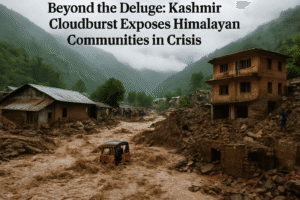Beyond the Deluge: Kashmir Cloudburst Exposes Himalayan Communities in Crisis
Sudden, devastating cloudburst struck Chashoti, Indian Kashmir, during a major Hindu pilgrimage (Machail Yatra), killing at least 46 people and leaving over 200 missing. Torrential rain triggered catastrophic flash floods and landslides, transforming roads into raging rivers and obliterating buildings, including a crowded community kitchen where pilgrims were lunching. Frantic rescue efforts by military and disaster teams are underway in treacherous terrain, hampered by destroyed infrastructure.
This tragedy highlights the extreme vulnerability of Himalayan communities and visitors to increasingly frequent, intense weather events. It follows closely on deadly floods in Uttarakhand, underscoring a disturbing regional pattern linked to climate change. Beyond the grim statistics, it represents profound human loss for families waiting in anguish and a stark warning about the urgent need for enhanced early warnings and resilient infrastructure in fragile mountain regions facing a “new abnormal.”

Beyond the Deluge: Kashmir Cloudburst Exposes Himalayan Communities in Crisis
In the remote pilgrimage town of Chashoti, Indian Kashmir, what began as a spiritual journey for hundreds of Hindu devotees transformed into a nightmare within minutes. Thursday’s sudden cloudburst—a meteorological phenomenon where 100+ mm of rain bombards an area within an hour—unleashed apocalyptic flooding that swept away entire buildings, vehicles, and human lives. As rescue teams comb through debris-choked valleys, the grim statistics (46 confirmed dead, 200+ missing) only hint at the profound human tragedy unfolding.
Why This Disaster Struck Deeper
- Pilgrimage Peril: The timing coincided with the Machail Yatra pilgrimage, where devotees trek to a high-altitude shrine. The flash flood targeted a crowded community kitchen at Chashoti’s road terminus—trapping hundreds during lunch. This convergence of faith and geography amplified casualties.
- Nature’s Fury, Human Vulnerability: Dramatic videos show mountainsides shedding walls of mud and rock—a signature of cloudbursts in fragile Himalayan ecosystems. Roads became torrents, security posts vanished, and the very infrastructure meant to protect pilgrims was obliterated.
- Resilience Meets Reality: Jammu and Kashmir’s Chief Minister Omar Abdullah acknowledged the “grim” reality as military and disaster teams mobilized. Helicopters now navigate treacherous valleys where roads no longer exist, underscoring the logistical hell facing rescuers.
The Climate Context Most Headlines Miss
This disaster isn’t isolated. Just weeks earlier, Uttarakhand—500 km southeast—saw similar deadly floods. Scientists warn such events are intensifying:
- Cloudburst Mechanics: Warm, moisture-laden air collides with Himalayan slopes, triggering violent, localized downpours. Traditional drainage systems fail instantly.
- The Deforestation Factor: Degraded forests and unchecked construction reduce soil’s water absorption capacity, turning rain into lethal runoff.
- A Pattern Emerging: Data shows cloudburst frequency in India has surged 300% since 1970 (IMD), with Kashmir witnessing repeated events since the devastating 2014 floods.
The Human Toll Beyond Numbers
Survivors describe a “roaring wave” of mud and water swallowing people mid-meal. Families now wait in hospitals and makeshift camps, clinging to hope for missing loved ones. The cancellation of Independence Day commemorations by local leaders speaks volumes about the trauma resonating across Kashmir.
What Comes Next?
While rescue efforts continue, urgent questions arise:
- How can early-warning systems be improved for remote Himalayan communities?
- Will pilgrimage routes be redesigned with climate resilience?
- Can infrastructure withstand what meteorologists call the “new abnormal”?
This tragedy underscores a brutal truth: in the era of climate change, sacred mountains have become frontlines. As Kashmir mourns, the world must recognize that cloudbursts aren’t just weather—they’re wake-up calls.
You must be logged in to post a comment.